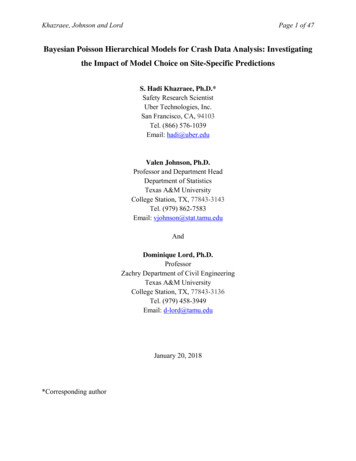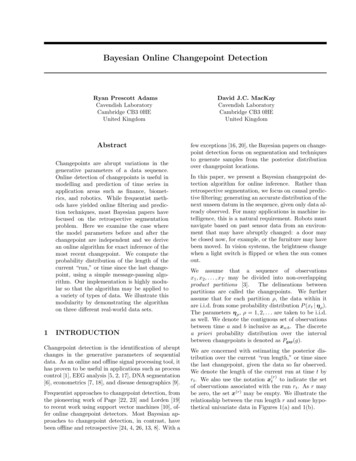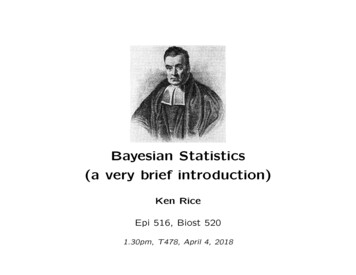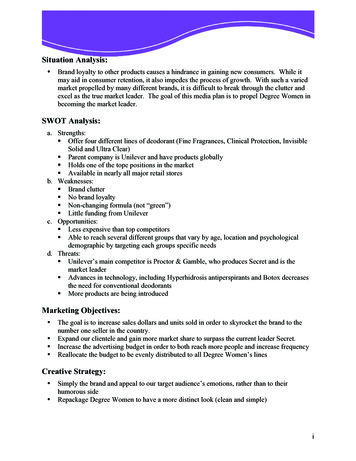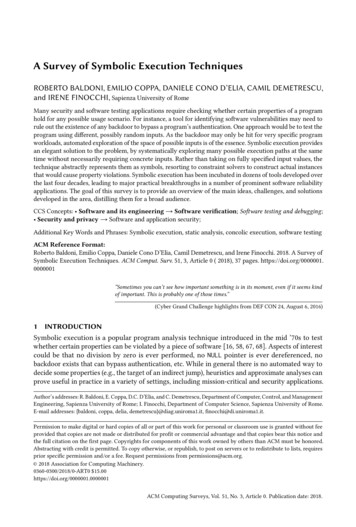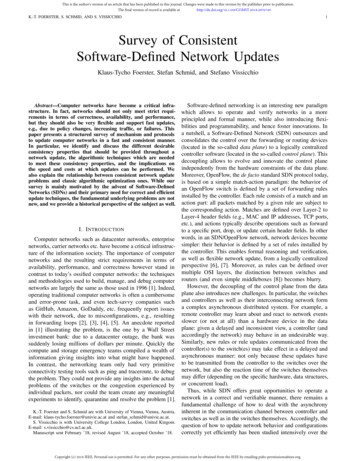
Transcription
Bayesian Analysis of Ordinal Survey Data using theDirichlet Process to Account for RespondentPersonality TraitsSaman Muthukumarana and Tim B. Swartz AbstractThis paper presents a Bayesian latent variable model used to analyze ordinal response survey data by taking into account the characteristics of respondents. Theordinal response data are viewed as multivariate responses arising from continuous latent variables with known cut-points. Each respondent is characterized bytwo parameters that have a Dirichlet process as their joint prior distribution. Theproposed mechanism adjusts for classes of personalities. The model is applied tostudent survey data in course evaluations. Goodness-of-fit (gof) procedures are developed for assessing the validity of the model. The proposed gof procedures aresimple, intuitive and do not seem to be a part of current Bayesian practice.Keywords : Dirichlet process, Goodness-of-fit, latent variables, MCMC, WinBUGS. Saman Muthukumarana is Assistant Professor, Department of Statistics, University of Manitoba,Winnipeg Manitoba, Canada R3T2N2. Tim Swartz is Professor, Department of Statistics and ActuarialScience, Simon Fraser University, 8888 University Drive, Burnaby British Columbia, Canada V5A1S6.Both authors have been partially supported by research grants from the Natural Sciences and EngineeringResearch Council of Canada. The authors thank two anonymous reviewers whose comments led to animprovement in the manuscript.1
1INTRODUCTIONFor the sake of convenience, many surveys consist of ordinal data, often collected on afive-point scale. For example, in a typical course evaluation survey, a student may express his view concerning an aspect of the course from a set of five alternatives: 1-poor,2-satisfactory, 3-good, 4-very good, and 5-excellent. Sometimes five-point scales havealternative interpretations. For example, the symmetric Likert scale measures a respondent’s level of agreement with a statement according to the correspondence: 1-stronglydisagree, 2-disagree, 3-neither agree nor disagree, 4-agree, and 5-strongly agree. Studentfeedback on course evaluation surveys represents a modern approach for measuring quality.Nowadays, a growing number of websites use student feedback as their main performanceindicator in teaching evaluations. As an example, http://www.ratemyprofessors.com/rate over one million professors based on student feedback on a five-point ordinal scale.The scenario is similar in customer satisfaction surveys and social science surveys.The simplest method of summarizing ordinal response data is to report the meanscorresponding to the ordinal scores for each survey question. At a slightly higher level ofstatistical sophistication, standard ANOVA methods may be applied to the ordinal scoresby treating the data as continuous. However, the standard models for the analysis ofordinal data are logistic and loglinear models (Agresti 2010, McCullagh 1980 and Goodmann 1979). These models correctly take into account the true measurement scales forordinal data and permit the use of statistical inference procedures for assessing populationcharacteristics. An overview of the methodologies for ordered categorical data is given byLiu and Agresti (2005).The approach in this paper is Bayesian and considers an aspect of ordinal survey datathat is sometimes overlooked. It is widely recognized that respondents may have differingpersonalities. For example, consider a company which conducts a customer satisfaction2
survey where there is a respondent with a negative attitude. The respondent may completethe survey with a preponderance of responses in the 1-2 range. In this case, a response of1 may not truly represent terrible performance on the part of the company. The responsemay reflect more on the disposition of the individual than on the performance of thecompany. As another example of an atypical personality, consider an individual who onlyprovides extreme responses of 1’s and 5’s. It would be useful if statistical analyses couldadjust for personalities. This is the motivation of the paper, and the tool which we use toaccount for personalities is the Dirichlet process, first introduced by Ferguson (1973). As aby-product of the proposed methodology, we attempt to identify areas (survey questions)where performance has been poor or exceptional. In addition, we attempt to identifyquestions that are highly correlated. Clearly, surveyors desire accurate responses and byidentifying highly correlated questions, it allows surveyors to remove redundant questionsfrom the survey which in turn reduces fatigue on the part of the respondents.Our paper is not the first Bayesian paper to consider this problem. AlternativeBayesian approaches include Johnson (1996), Johnson (2003), Dolnicar and Grun (2007),Rossi, Gilula and Allenby (2001), Kottas, Mueller and Quintana (2005), Javaras andRipley (2007) and Emons (2008). Johnson (2003) uses a hierachical ordinal regressionmodel with heterogenious thresholds structure. Dolnicar and Grun (2007) use a ANOVAapproach to assess the inter-cultural differences in responses. Rossi, Gilula and Allenby(2001) address nonidentifiability and parsimony by imposing various complex constraintson the unknown cut-points. Kottas, Mueller and Quintana (2005) propose a nonparametric Bayesian approach to model multivariate ordinal data recorded in contingency tables.One of the main features of this paper is that there is a mechanism to cluster subjectsbased on personalities. Most importantly, in our approach, clustering takes place as apart of the model and data determine the clustering structure. Often, clustering is done3
in a post hoc fashion, following some fitting procedure.In addition to the methodological contribution provided in this paper, issues related toscaling are also considered. Not only does the approach attempt to remove idiosyncraticscaling, assumptions are made about the manner in which individuals transform latentcontinuous scores to discrete scores. There is a considerable literature on the psychologyof survey response, the impact of survey question format, the effect of scales, etc. Fora brief introduction to some of these topics, the reader is referred to Tourangeau et al.(2000), Fanning (2005) and Dawes (2008). For an introduction to the analysis of ordinaldata in the applied fields of education and medicine, the reader is referred to Cohen,Manion and Morrison (2007), and Forrest and Andersen (1986) respectively.In section 2, we provide a detailed development of the Bayesian latent variable modelproposed in the paper. The model assumes that ordinal response data arise from continuous latent variables with known cut-points. Furthermore, each respondent is characterized by two parameters that have a Dirichlet process as their joint prior distribution.The mechanism adjusts for classes of personalities leading to standardized scores for respondents. Prior distributions are defined on the model parameters. We provide detailsabout nonidentiability in our model and we overcome nonidentifiability issues by assigningsuitable prior distributions. Computation is discussed in section 3. As the resulting posterior distribution is complex and high-dimensional, we approximate posterior summarystatistics which describe key features in the model. In particular, posterior expectationsare obtained via MCMC methods using WinBUGS software (Spiegelhalter, Thomas andBest 2003). In section 4, the model is applied to actual student survey data obtained incourse evaluations. A comparison is made with an analysis based on the methodology ofRossi, Gilula and Allenby (2001). We then demonstrate the reliability of the approachvia simulation. In section 5, goodness-of-fit procedures are developed for assessing the4
validity of the model. The proposed procedures are simple, intuitive and do not seem tobe a part of current Bayesian practice. We conclude with a short discussion in section 6.2MODEL DEVELOPMENTConsider a survey where the observed data are described by a matrix X : (n m) whoseentries Xij are the ordinal responses. The n rows of X correspond to the individuals whoare surveyed and the m columns refer to the survey questions. Without loss of generality,we assume that the responses are taken on a five-point scale.We assume that the discrete response Xij of individual i to survey question j arisesfrom an underlying continuous variable Yij . We consider a cut-point model which convertsthe latent variable Yij to the observed Xij as follows:Xij 1 λ0 Yij λ1Xij 2 λ1 Yij λ2Xij 3 λ2 Yij λ3(1)Xij 4 λ3 Yij λ4Xij 5 λ4 Yij λ5Up until this point, our approach is identical to that of Rossi, Gilula and Allenby(2001). Our approach now deviates as we assume that the cut-points are known and aregiven by λ0 , λ1 1.5, λ2 2.5, λ3 3.5, λ4 4.5 and λ5 . We suggestthat the chosen cut-points correspond to the way that respondents actually think. Whenasked to supply information on a five-point scale, we hypothesize that respondents makeassessments on the continuum where the values 1.0, . . . , 5.0 have precise meaning. Therespondents then implicitly round the continuous score to the nearest of the five integers.Although our methodology can be modified using unknown cut-points, the estimation of5
cut-points introduces difficulties involving nonidentifiability. Rossi, Gilula and Allenby(2001) address nonidentifiability and parsimony by imposing numerous constraints on thecut-points.It is interesting to compare our rationale for the Yij Xij transformation with therange-frequency model proposed by Parducci (1965). The range principle suggests that arespondent uses extreme stimuli to fix the interpretation of endpoints on a discrete scale,and these endpoints provide reference for intermediate scale values. The principle isconsistent with our transformation rationale as rounding is a subsequent step to markinglatent variables on a continuum. On the other hand, the frequency principle appears tobe violated as there is no reason to expect constant frequencies between scales values.This departure may be expected on the grounds of a reference point effect where Likertscale values, for example, have specific meanings. The frequency-range model and variousdepartures from the model are discussed in Tourangeau et al. (2000).Using the notation Yi (Yi1 , . . . , Yim )0 , Rossi, Gilula and Allenby (2001) considerYi Normal(µ τi 1, σi2 Σ)(2)for i 1, . . . , n where τi and σi are respondent-specific parameters used to address scaleusage heterogeneity. For example, a large τi and small σi 0 characterize a respondentwho uses the top end of the scale. Further, the model (2) implies a standardized response(Yij µj τi )/σi through which the correlation between survey questions may be assessed.A consequence of the model is that correlation inferences between survey questions maydiffer considerably when scale usage characteristics are considered.Although (2) contains many of the features we desire, it cannot, for example, adequately model an individual whose responses are mostly intermediate values such as 2’s6
and 4’s. We instead consider a structure that has similarities to (2). We proposeYi Normal(bi (µ ai 1 31) 31, b2i Σ)(3)where we adjust for personalities via a “pure” or standardized score for the ith individualgiven by Zi (Zi1 , . . . , Zim )0 Normal(µ, Σ) such thatYij bi (Zij ai 3) 3(4)for i 1, . . . , n, j 1, . . . , m.It is (4) that provides an interpretation for the latent responses Zi and Yi , and forthe parameters ai and bi corresponding to the ith individual. We observe that Zi is astandardized latent score which is independent and identically distributed across respondents. The vector µ corresponds to the mean response of standardized scores over thepopulation of respondents, and the matrix Σ describes the variability of these scores andthe correlation between survey questions. The latent score Yi is obtained from Zi via (4)where Yi includes the personality characteristics (ai , bi ) of the ith respondent. Unlike theZi , we note that the Yi in (3) are not identically distributed. Therefore, the learning of(ai , bi ) can be thought of as a denoising method where the pure response Zi is derivedfrom the noisy Yi which includes personality traits.For an interpretation of the disposition parameter ai R in (4), it is initially helpfulto consider ai conditional on bi 1. In this case, when ai 0, the ith respondent hasa neutral disposition and the latent response Yij is equal to the standardized score Zij .When ai 0 (ai 0), the ith respondent has a positive (negative) attitude since Zij isadjusted by ai to give Yij .For an interpretation of the extremism parameter bi 0 in (4), it is helpful to considerbi conditional on ai 0. In this case, when bi 1, the amount by which Zij exceeds 3.0is magnified and is added to 3.0 and gives a more extreme result towards the tails on the7
five-point scale. When 0 bi 1, the extremism parameter has the effect of pulling thelatent response Yij closer to the middle. A respondent whose bi 0 might be described asmoderate and we impose the constraint bi 0 to avoid nonidentifiability. Note that theparameter σi in (2) addresses variability which is somewhat different from our concept ofextremism.To provide a little more clarity, when Zij ai 3 0, the ith respondent is positivelyinclined towards survey question j. When Zij ai 3 0, the i-th respondent isnegatively inclined towards survey question j. The quantity Zij ai 3 is then scaled bybi to account for extremism on the part of the i-th respondent. The personality differentialbi (Zij ai 3) is then added to 3 to yield the latent variable Yij . Note that whereas azero score for bi (Zij ai 3) represents ambivalence (neither agree nor disagree in theLikert setting), Yij 3 represents ambivalence i
Bayesian Analysis of Ordinal Survey Data using the Dirichlet Process to Account for Respondent Personality Traits Saman Muthukumarana and Tim B. Swartz Abstract This paper presents a Bayesian latent variable model used to analyze ordinal re-sponse survey data by taking into account the characteristics of respondents. The ordinal response data are viewed as multivariate responses
